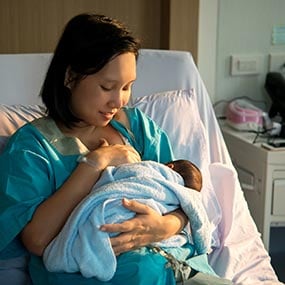Hepatitis B or C Infections
Mothers with Hepatitis B or C infections can breastfeed their infants.
Hepatitis B

Hepatitis B is a liver infection caused by the hepatitis B virus (HBV), which is transmitted by blood, semen or other body fluid from an infected person. A woman with hepatitis B can infect her infant with the virus during childbirth. All pregnant women [PDF-864KB] are given a blood test for hepatitis B as part of their prenatal care or when they arrive at the hospital to give birth. CDC recommends that babies get the first dose of the hepatitis B vaccine before leaving the hospital or within the first 24 hours. Babies are usually given the second dose of the vaccine 1-2 months after the first dose, and the third dose by the time they are 18 months old.
Is it safe for a mother infected with hepatitis B virus (HBV) to breastfeed her infant?
Yes. All infants born to HBV-infected mothers should receive hepatitis B immune globulin (HBIG) and the first dose of hepatitis B vaccine within 12 hours of birth. The second dose of vaccine should be given at age 1–2 months, and the third dose at age 6 months. The infant should be tested after completion of the vaccine series, at age 9–12 months (generally at the next well-child visit), to determine if the vaccine worked and that the infant is not infected with HBV through exposure to the mother’s blood during the birth process. However, there is no need to delay breastfeeding until the infant is fully immunized. The risk of HBV mother-to-child transmission through breastfeeding is negligible if infants born to HBV-positive mothers receive the HBIG/HBV vaccine at birth.
Learn more about HBV infection.
Is it safe for the HBV-positive mother to breastfeed if her nipples are cracked and bleeding?
Data are insufficient to say yes or no. However, HBV is spread by infected blood. Therefore, if the HBV-positive mother’s nipples and/or surrounding areola are cracked and bleeding, she should stop nursing temporarily. To maintain her milk supply while not breastfeeding, she can express and discard her breast milk until her nipples are healed. Once her nipples are no longer cracked or bleeding, the HBV-positive mother may fully resume breastfeeding. Providers may need to refer mothers for lactation support to learn how to maintain milk production and how to supplement with pasteurized donor human milk or formula while temporarily not breastfeeding.
Hepatitis C
Hepatitis C is a liver infection caused by the hepatitis C virus (HCV), which is transmitted by blood from an infected person. There is no vaccine for hepatitis C. The best way to prevent hepatitis C is by avoiding behaviors that can spread the disease, especially injecting drugs.
Is it safe for a mother infected with hepatitis C virus (HCV) to breastfeed her infant?
Yes. There is no documented evidence that breastfeeding spreads HCV. Therefore, having HCV-infection is not a contraindication to breastfeed.
Is it safe for the HCV-positive mother to breastfeed if her nipples are cracked and bleeding?
Data are insufficient to say yes or no. However, HCV is spread by infected blood. Therefore, if the HCV-positive mother’s nipples and/or surrounding areola are cracked and bleeding, she should stop nursing temporarily. To maintain her milk supply while not breastfeeding, she can express and discard her breast milk until her nipples are healed. Once her nipples are no longer cracked or bleeding, the HCV-positive mother may fully resume breastfeeding. Providers may need to refer mothers for lactation support to learn how to maintain milk production and how to supplement with donor human milk or formula while temporarily not breastfeeding.
Visit CDC’s Viral Hepatitis C Frequently Asked Questions for additional information on HCV infection and pregnancy.
- Recommendations for prevention and control of hepatitis C virus (HCV) infection and HCV-related chronic disease. MMWR, 47(RR-19):1–39
- Schillie S, Vellozzi C, Reingold A, et al. (2018). Prevention of Hepatitis B Virus Infection in the United States: Recommendations of the Advisory Committee on Immunization Practices. MMWR, 67(RR-1):1–31.
